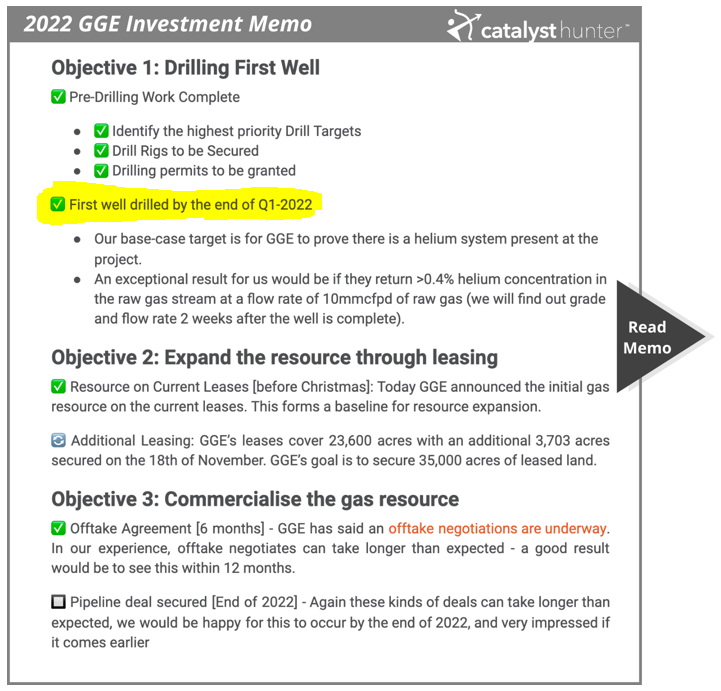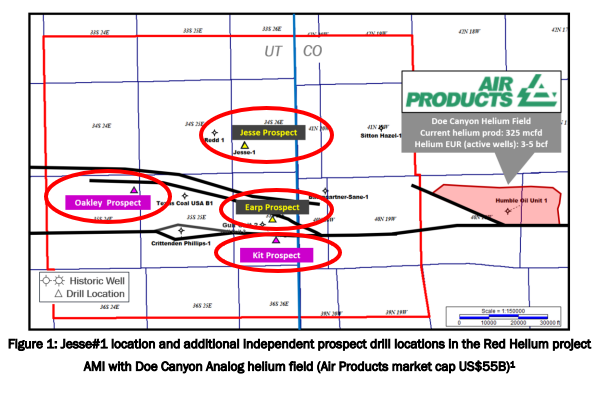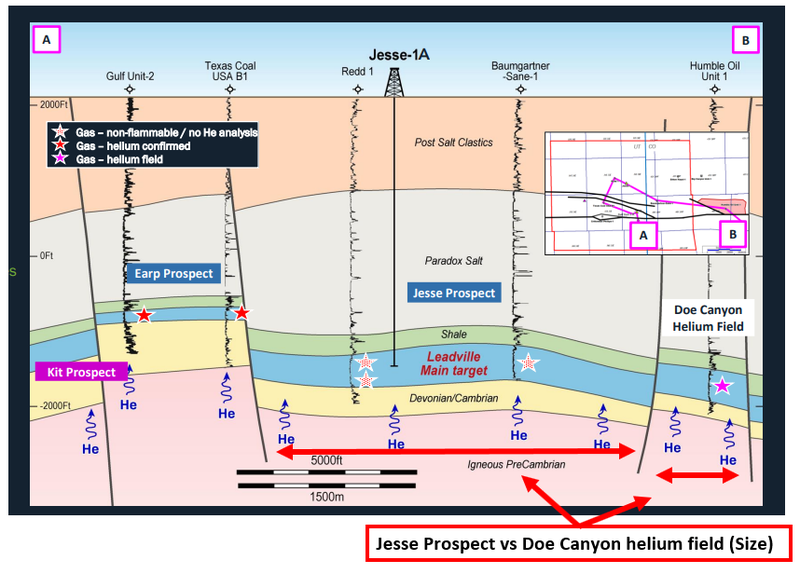GGE Hits Gas Column. Flow Rate and Helium Concentration to be Tested Next
Disclosure: S3 Consortium Pty Ltd (the Company) and Associated Entities own 32,510,000 GGE shares at the time of publishing this article. The Company has been engaged by GGE to share our commentary on the progress of our Investment in GGE over time.
Our 2021 Catalyst Hunter Pick of the Year Grand Gulf Energy (ASX:GGE) now has the first of the three key pieces it needs to announce a new helium discovery.
Those key pieces of information we are looking for is as follows:
- A proven gas system ✅
- Flow Rates - An outcome is due in about 3 weeks 🔄
- Helium concentrations - An outcome is due in about 3 weeks 🔄
Drilling is now complete at the Jesse #1A well and GGE has confirmed it has intercepted a gross gas column measuring ~203 feet (~62 metres).
Importantly, the ~203 foot intercept was made across a primary target which GGE was previously estimating to be at depths of between 8,100 feet and 8,300 feet. This means GGE has effectively managed to intercept gas columns throughout the entire primary target area.
GGE also confirmed that it has secured a workover rig that is expected to be on site at the Jesse #1A well location to start flow rate testing in around two weeks.
With a gas structure intercepted, the only things left for GGE to prove out before a new helium discovery can be announced is A) a commercially viable raw gas flow rate and B) commercially viable helium concentrations in this gas.
After checking the flow rates being achieved at the nearby Doe Canyon Helium Field (which is already operating and producing ~10.7M cubic feet of helium per month), we set the following expectations for GGE’s planned upcoming flow testing:
- Bullish case (Exceptional result) = GGE returns >0.4% helium concentration in the raw gas stream at a flow rate of 10mmcfpd of raw gas. In our opinion, this would constitute a commercial discovery and could immediately be tied into the offtake partners processing facility, moving GGE from explorer to producer.
- Base case (Good result) = GGE to prove there is a helium system present at the project. If GGE intercepts a helium structure, it can be followed up with additional drilling programs.
- Bearish case (Poor result) = If GGE fails to produce a flow test and/or the flow test returns no helium concentrations. This would be a poor result but given GGE still have plenty of other targets it can drill, no matter what the results are from the Jesse #1A well, GGE will still have at least another three shots at making a large-scale helium discovery over its project area.
Yesterday’s announcement is a positive first sign that a gas system is present, but the flow testing will be the ultimate determinant of whether GGE has made a new helium discovery.
If successful, GGE could not have timed the discovery of a new US based domestic helium discovery any better.
With the recent shutdown of Russia’s Armur helium facility (capable of producing ~11% of global supply) due to an unexpected fire and the shutdown of Cliffside Helium Plant (the biggest producer in the US), helium prices have been trading as high as US$2,000-US$3,000 per mcf.
When GGE first acquired its interest in its helium project last year, helium was trading between US$350-600 per Mcf.
GGE also has a buyer ready for any new helium discovery. It has signed an offtake agreement and strategic alliance with Paradox Resources, the owner of the nearby Lisbon helium production plant.
In the event GGE can achieve our “exceptional case” result, the Jesse #1A well could immediately be tied into Paradox’s nearby pipeline infrastructure and then processed through its production plant.
The flow testing results is all that’s left before GGE can achieve our key objective #1, Drilling First Well, that we set in our 2022 Investment Memo. We expect these within the next ~three weeks.
To see all of our key objectives and GGE’s progress check out our 2022 GGE Investment Memo by clicking on the image below:

More on yesterday’s announcement:
Yesterday’s drilling update confirmed that the Jesse #1A well had been drilled to its intended total depth (which GGE had previously referenced at ~8,300 feet).
The highlight of the announcement was GGE intercepting a 203 feet (~62 metre) gross gas column.
Considering that GGE’s primary drilling target was between ~8,100 feet and 8,300 feet, it effectively intercepted gas columns for that entire zone which it had initially set as its “primary target”.
GGE also confirmed that a workover rig had been sourced and that it was expected to be on site at the Jesse #1A well location for flow rate testing within ~ two weeks time.
With the flow testing work to be the ultimate determinant of whether or not GGE has made a new helium discovery, yesterday’s news was a positive first sign of what could be coming within the next ~ three weeks.
After yesterday’s announcement we know:
- GGE intercepted a gross gas column measuring ~203 feet (~62 metres) – almost the entire size of the primary target area the drilling was focused on.
- A workover rig had been secured with flow rate testing expected to commence within two weeks.
Why should we care about the massive gas column that GGE intercepted?
It might seem confusing with GGE announcing a “gas column intercept”, After all, GGE’s Jesse #1A well was a pure play helium exploration well.
The fact of the matter is that helium is produced from commercially flowing gas wells.
A large gas column intercept (such as GGE’s ~62 metre intercept) could indicate a potential discovery of a large reservoir. For some context, some of the biggest ever gas discoveries in Australia have had smaller gas fields discovered in them with intercepts as low as ~20m in size.
The thickness of the intercept is a positive first sign that GGE has hit something of interest.
For helium to be produced, a large working gas reservoir needs to be defined. And the larger the reservoir, the higher the ultimate flow rate is likely to be.
Why is flow testing so important?
This is where the important work is done when in search of helium.
GGE knows they have a ~62 metre thick gas bearing structure but are missing two key inputs before it can announce a helium discovery.
To announce a new helium discovery, GGE needs to first prove that the well is flowing at commercial rates of GAS, and then prove that the helium concentrations in that gas are high enough to produce helium products.
With a workover rig secured, GGE expects to start the flow testing work within the next two weeks, meaning it’s not long until we have those two key inputs — the well’s flow rate and helium concentrations.
What are we looking for from the flow testing results?
Again, three key pieces are needed to announce a helium discovery:
- A proven gas system ✅
- Commercially viable flow rates 🔄
- Commercially viable helium concentrations 🔄
The first of the three key ingredients can be checked off with GGE’s announcement of a 62m gas column intercept. The other two ingredients will be figured out with the upcoming flow rate testing.
We set the following expectations for the drilling results from the Jesse #1A well:
- Bullish case (Exceptional result) = GGE returns >0.4% helium concentration in the raw gas stream at a flow rate of 10mmcfpd of raw gas. In our opinion, this would constitute a commercial discovery and could immediately be tied into the offtake partners' processing facility. GGE could move from explorer to producer off the back of Jesse #1A alone.
- Base case (Good result) = GGE identifies a working helium structure. If GGE intercepts a helium structure, it can be followed up with additional drilling programs.
- Bearish case (Poor result) = If GGE fails to produce a flow test and/or the flow test returns no helium concentrations.
🎓 = To learn more about how we go about setting our expectations for drilling events check out our educational article here.
Plenty of other targets to follow up after this well
The Jesse #1A results are likely in under three weeks' time, so we’ve started looking ahead to what’s next for GGE.
In a previous note we covered the potential exploration upside at GGE’s project, which gives an indication of just how big GGE’s project could become.
Here are the two key takeaways from that note:
- GGE has identified three NEW potential drill locations in addition to the Jesse Prospect
- GGE has identified four mature step out drilling locations at the Jesse Prospect
Let’s take a closer look at these potential targets.
First, the three NEW exploration prospects.
GGE has three independent prospects, in addition to the Jesse Prospect, that can be followed up in future drilling programs:

These prospects all came about after GGE re-processed ~315km of 2D seismic data and after the results of six historic wells over the project area were analysed.
The result of all this analysis was the identification of three NEW independent prospects.
The key word is that they are “independent”.
Including the Jesse prospect, GGE has a total of four unrelated prospects that it can drill with the aim of making a new helium discovery. Effectively, no matter what the results are from the Jesse #1A well, GGE will still have at least another three shots at making a large-scale helium discovery over its project area.
Better yet, if the Jesse #1A well is a success, GGE can drill out these additional projects to increase the project size and start producing helium from different reservoirs.
Below is an image of the four prospects.

Second, GGE has identified four mature step-out drilling locations at Jesse.
In the event of a successful discovery at the Jesse #1A well, GGE has four technically mature step-out drilling targets that it can follow up with drilling.
“Step-out” refers to targets that could be drilled with the aim of extending the size of any discovery made with the first well at the Jesse prospect.
If GGE makes a successful discovery with the Jesse #1A well, it could follow this up with another four separate wells across the Jesse prospect, aiming to increase production from a known helium reservoir.
For context, the Doe Canyon Field, which sits ~15 miles (~24km) east of GGE’s project area, is producing ~10.7m cubic feet of helium per month, the bulk of which comes from only seven wells.
Instead of riskier exploration drilling, GGE can simply re-enter the Jesse prospect across those four locations and increase production by tapping into the known discovery.
The obvious caveat here is that this is all contingent on a successful discovery from the Jesse #1A well — which will be known in under three weeks.

Our 2022 GGE Investment Memo
Below is our 2022 Investment Memo for GGE where you can find a short, high level summary of our reasons for investing.
The ultimate purpose of the memo is to track the progress of our portfolio companies using our Investment Memo as a benchmark, throughout 2022.
In our GGE Investment Memo you’ll find:
- Key objectives for GGE in 2022
- Why we continue to hold GGE
- What the key risks to our investment thesis are
- Our investment plan
General Information Only
S3 Consortium Pty Ltd (S3, ‘we’, ‘us’, ‘our’) (CAR No. 433913) is a corporate authorised representative of LeMessurier Securities Pty Ltd (AFSL No. 296877). The information contained in this article is general information and is for informational purposes only. Any advice is general advice only. Any advice contained in this article does not constitute personal advice and S3 has not taken into consideration your personal objectives, financial situation or needs. Please seek your own independent professional advice before making any financial investment decision. Those persons acting upon information contained in this article do so entirely at their own risk.
Conflicts of Interest Notice
S3 and its associated entities may hold investments in companies featured in its articles, including through being paid in the securities of the companies we provide commentary on. We disclose the securities held in relation to a particular company that we provide commentary on. Refer to our Disclosure Policy for information on our self-imposed trading blackouts, hold conditions and de-risking (sell conditions) which seek to mitigate against any potential conflicts of interest.
Publication Notice and Disclaimer
The information contained in this article is current as at the publication date. At the time of publishing, the information contained in this article is based on sources which are available in the public domain that we consider to be reliable, and our own analysis of those sources. The views of the author may not reflect the views of the AFSL holder. Any decision by you to purchase securities in the companies featured in this article should be done so after you have sought your own independent professional advice regarding this information and made your own inquiries as to the validity of any information in this article.
Any forward-looking statements contained in this article are not guarantees or predictions of future performance, and involve known and unknown risks, uncertainties and other factors, many of which are beyond our control, and which may cause actual results or performance of companies featured to differ materially from those expressed in the statements contained in this article. S3 cannot and does not give any assurance that the results or performance expressed or implied by any forward-looking statements contained in this article will actually occur and readers are cautioned not to put undue reliance on forward-looking statements.
This article may include references to our past investing performance. Past performance is not a reliable indicator of our future investing performance.

